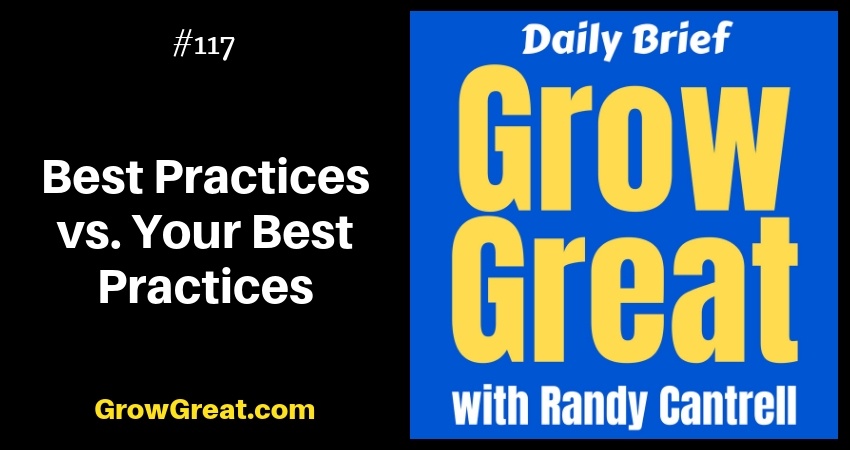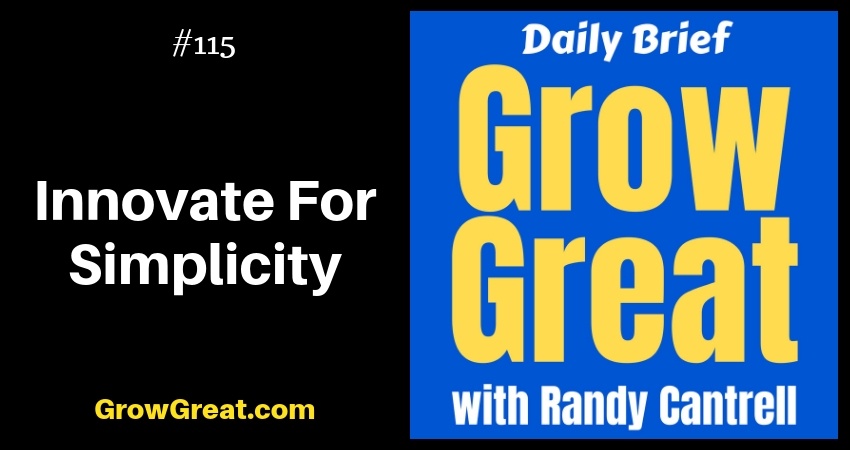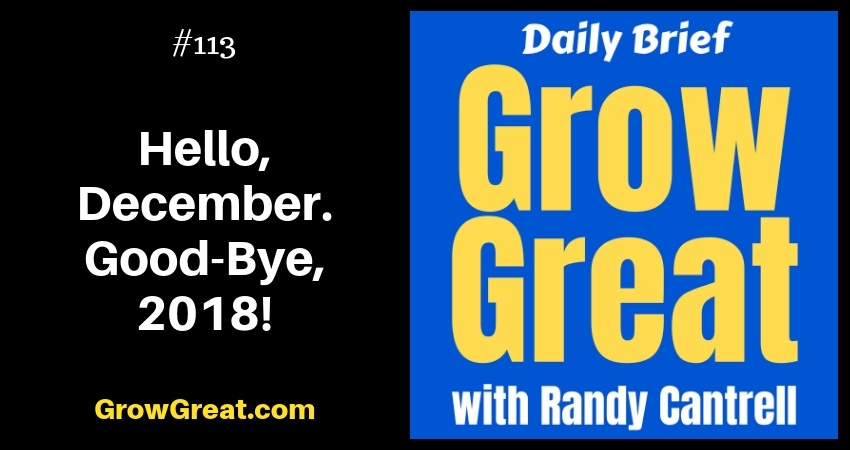Best Practices vs. Your Best Practices – Grow Great Daily Brief #117 – December 7, 2018
Podcast: Play in new window | Download (Duration: 9:26 — 9.8MB)
Subscribe: Apple Podcasts | Spotify | Email | RSS | More
Benchmarking began to be popular business jargon back in the 80’s. At least that’s when I first began to hear about it. Wikipedia has some interesting history on the term.
The term benchmark, originates from the history of guns and ammunition, and with the same aim as for the business term; comparison and improved performance. The introduction of gunpowder arms replaced the bow and arrow from the archer, the soldier who used the bow. The archer now had to adapt to the new situation, and learn to handle the gun. The new weapon left only a mark on the target, where the arrow used to be visible, and with the bow gone, the soldiers title changed to marksman, the man who put the mark. The gun was improved already in the early beginning, with rifling of the barrel, and the rifle was born. With the industrialization of the weapon-industry in the mid-1800’s, The mass production of ammunition as a cartridge replaced the manual loading of black-powder and bullet into the gun. Now, with standardized production of both the high-precision rifle, as well as the cartridge, the marksman was now the uncertain variable, and with different qualities and specifications on both rifle as well as ammunition, there was a need for a method of finding the best combination. The rifled weapon was fixed in a bench, making it possible to fire several identical shots at a target to measure the spread. This is benchmarking, as it is still done today, both at the gun-factory, the ammunition-factory, as well as for a lot of sportsmen who look for the best ammunition to bring to competition.
In short, benchmarking and best practices have been considered interchangeable terms denoting the standards that have been established by industry leaders. Think of it as the current established level of high achievement. It’s not an ideal, but a realized actuality of somebody or some company in a particular area of endeavor.
Best practices on one industry may not quite mirror those in another. Typically, we look within our industry to see what the top performers are doing. They set the standard, the benchmark or best practices.
I’ve always been interested in the benchmarks or best practices, but I’ve also always found them very limiting. Probably for the same reason I find today’s social media quotes so empty. Quotable quotes are nice and all, but your business success and your leadership success aren’t likely going to be impacted by some notable (perhaps completely untrue) quote. For starters, the quotes usually have no context. Additionally, they tend to be stated in absolutes because that gives them perceived authority and power. Words like “always” and “never” are dead giveaways. But we can blitzed with such things and they enter our individual and collective consciousness – and over time, we begin to believe them. So they do have an effect on us. No denying it.
Just this morning I saw one that said, “The problem isn’t the problem. It’s your reaction to the problem.” Really? I’m not so sure. And what does that even mean? If your building roof leaks, you have a problem. I don’t see how your reaction to that problem – getting it fixed, either temporarily or permanently – is the problem. No, the roof leaks. That’s my problem. I’m doing what I must to fix it. No problem. 😀
Well, back to best practices or benchmarking. I have a few basic problems with it.
One, it presupposes that somebody has figured out how to best do it – whatever IT is. But have they? Sure, we can measure various elements of performance to determine what success looks like. We know high achievement versus lower achievement. But because another business has established, or helped establish benchmarks or best practices doesn’t mean it can be replicated. Or even that it should be.
Two, it doesn’t mean it’s literally the best, it just means for them, at this moment in time, it’s better than anything from the past. Like all performance, it’s a moment in time. Consistently good performance over time is how most of us view success. Yes, there are outliers. Those founders of some tech company who started in their college dorm room 10 months ago and now they’re blessed with a multi-million dollar exit. It happens. But it’s rarer than anything you can compare it to. It gets a ton of press and fools us into thinking we’ve been laboring for years and there’s no multi-million exit in sight.
Three, it’s limiting. The realized potential is…well, real. It’s how things are. But too often benchmarking and best practices don’t give enough license to how great things could be. It’s 4-minute-mile stuff. Barrier-breaking doesn’t happen because somebody is following a benchmark or best practice. It happens because they refuse to.
Best for you may be similar to best practices in your industry, but maybe not. You may be able to blow best practices out of the water in your own way.
I’m not telling to avoid reading about and learning whatever benchmarks exist in your space. I’m telling you to take them with a grain of salt, knowing they may have no bearing on how you should roll.
Context Matters
More than 20 years I embraced a fascination with home delivery of big-ticket items, namely major home appliances and big, flat panel TVs. That was my space. Best practices nationally were next day delivery. We offered same-day delivery as a premium service. And it was popular, for obvious reasons. If your refrigerator is out today is way better than tomorrow.
I challenged my team to find a way to up the game with a 4-hour delivery. I knew of no other retailer in any market of size doing such a thing. That was part of the fun. To go where no man had ever gone before and all that. Within 30 days our team figured out a way to get it done. And you know what? It wasn’t nearly as tough as you might imagine. It became second nature. It wasn’t an exception to the rule, it was pretty much an established rule because we found our own best practices. And what fit us was vastly superior, in my opinion, and the opinions of our shoppers, than the existing benchmarks in our space.
This is among the chief reasons I constantly am pushing you to FIGURE IT OUT. Figuring it out is fun and profitable. It’s also beneficial as you stop trying to copycat behaviors and practices that may be less than what you’re capable of. I could have said, we’re way ahead of the industry best practices. No need to push harder. But for us, that wasn’t fun. And we wanted to improve. To grow. To get better!
What about you?
What do you want? Because you’re willing to listen a podcast with the title GROW GREAT, I’m guessing you’re not quite satisfied with how things are. Maybe they’re good. Maybe they’re very good. Maybe they’re not good at all. Maybe you’re struggling. Whatever your condition, you’re dissatisfied. You think (or you believe, or you want to believe) things can be better. And you likely think you have some capacity to help make it so.
I agree with you.
You do have the power to influence an improved outcome.
You also have the power to figure out what best practices look like inside your own company. Yes, it helps to have people contributing to that effort. Yes, who you surround yourself matters. But at the end of the day – at the end of each day – you must decide what you want to do. And how you want to go about making it happen.
Be well. Do good. Grow great!

Best Practices vs. Your Best Practices – Grow Great Daily Brief #117 – December 7, 2018 Read More »




